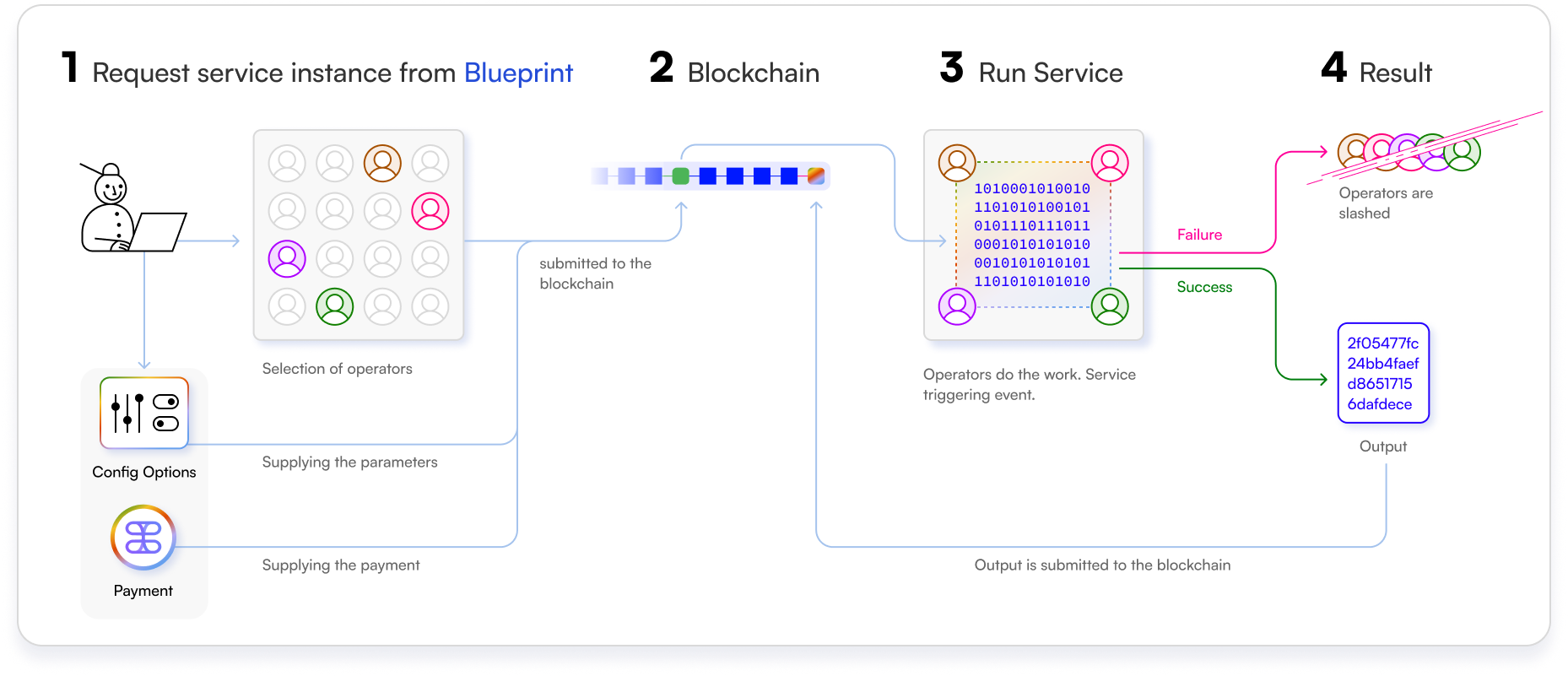Blueprints
Blueprints are specifications for Actively Validated Services (AVS) on the Tangle Network. An AVS is an off-chain service that runs arbitrary computations for a user-specified period of time. A Blueprint is defined by:
- An off-chain program binary (known as a Blueprint Gadget)
- A set of smart contracts that provide programmability over the service's output verification and handling of malicious failures
Tangle's Gadget SDK Repo
Check out our Gadget SDK repository to get started building your own gadgets.
Hello World Blueprint
Get started with a simple Hello World example using Tangle Blueprints.
Build an Eigenlayer AVS
Build an Eigenlayer AVS with the Tangle Blueprint SDK and hook into a variety of EVM compatible utilities for task automation, slashing, and more.
Blueprint and Service Instance Lifecycle

Blueprints interact with the Tangle Network in several key ways:
- Blueprints are deployed to Tangle, with their metadata and smart contracts stored and deployed on-chain.
- Blueprints are instantiated, triggering the creation of an Instance, which represents a single AVS. The Instance runs for a modifiable period of time.
- Blueprints are destroyed once they reach their time-to-live (TTL) or run out of funds to incentivize operators to run their service.
Blueprints provide a useful abstraction, allowing developers to create reusable service infrastructures as if they were smart contracts. This enables developers to monetize their work and align long-term incentives with the success of their creations, benefiting proportionally to their Blueprint's usage.
The Blueprint object is the core restaking object in Tangle, implemented primarily in the pallet-services module of the Tangle codebase. Assets are viewed as being restaked on Blueprints, with Operators running Instances of Blueprints and users restaking/staking their assets with those Operators.
Detailed Interactions
Developers
Developers interact with Tangle Blueprints by deploying them to the blockchain. A Blueprint specification contains metadata and smart contracts, currently targeting the EVM. The smart contracts are deployed to the Tangle EVM, while the metadata is stored in Tangle's runtime.
The Blueprint includes two key smart contracts:
- Registration Contract: Specifies how Operators register for the Blueprint, allowing the developer to add additional fees, access control, KYC, and any other EVM-deployable functionality to the registration process.
- Request Contract: Defines how consumers of Blueprints initiate Service Instances, providing the same customizability as the EVM for the initialization process of Service Instances.
The metadata stores and controls the off-chain service of the Blueprint, known as the Blueprint Gadget, which represents the location of the program binary (open-source or potentially closed-source) that executes the off-chain service. The metadata can be updated as the Blueprint evolves.
Blueprint upgrades are handled differently than runtime upgrades and should eventually be supported through an additional Blueprint smart contract for governance. Upgrades should not overwrite previous versions to protect against malicious updates to active and future services. Instead, upgrades allow for a form of Operator lock-in, enabling developers to quickly benefit from the success of existing services and pass liquidity, as users can request "new versions" of the Blueprint while accessing the already restaked capital from the success of previous versions.
Blueprints empower developers to create, customize, and monetize technical service configurations on the Tangle Network, defining features, behavior, resource requirements, and the Gadget binary for services such as Threshold MPC, zero-knowledge provers, AI infrastructure, and more. Developers can programmatically incentivize Operators to restake on their services and update them to improve and benefit from their long-term success. Tangle Blueprints are designed for reuse by various users and projects.
Consumers
Tangle Network provides a user-friendly platform for consumers to discover, deploy, and manage Blueprint Instances. Consumers can access tailored technical services with varying configurations and features, specify their requirements (e.g., threshold of participants, registration criteria), and select a subset of Operators to provide the service. The stake recursion process increases the economic security of reliable services.
Consumers interact with Tangle by initializing Blueprints, which create Blueprint Instances. To initialize an Instance, a consumer:
- Selects a participation selection strategy that satisfies the Blueprint's Request smart contract constraints. Participation strategies may not be necessary if there are no constraints, as any subset could generally be selected for the Instance.
- Provides additional metadata required by the Blueprint's Request smart contract.
- Pays the fee required for the Instance configuration.
Operators
Operators are incentivized to provide the services specified in the Blueprints to consumers through a reward system funded by the staking and recursion process. TNT holders govern this process, deciding which Blueprints receive incentives based on their value to the network. Operators play a vital role in maintaining the decentralized infrastructure and ensuring the availability and performance of the services offered. They also provide the value of sorting Blueprints by utility, unless co-opted for malicious intent.
Delegators and Nominators
Delegators and Nominators contribute to the economic security of the Tangle Network by providing liquidity through the stake recursion process. They earn rewards based on their participation and the network's overall performance. The inflation and reward distribution mechanism incentivizes both developers and restakers, with a portion of the inflationary rewards directed to developers who create attractive services that attract liquidity from restakers.
Composability and Ecosystem
Blueprints can be composed and linked together to create sophisticated, interoperable applications, fostering innovation and collaboration within the Tangle ecosystem. The Tangle architecture is uniquely suited for complex cryptographic applications, such as multi-party computation (MPC) and zero-knowledge (ZK) services, as well as oracles, custody solutions, bridge co-processors, and proving networks. Developers are encouraged to collaborate and contribute to expanding the library of apps and services on Tangle, and will be rewarded with incentives for their valuable contributions.